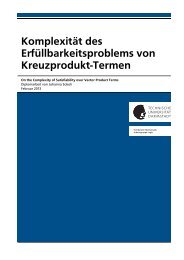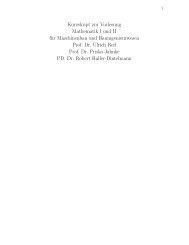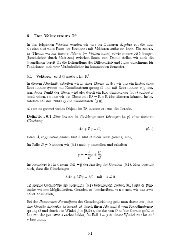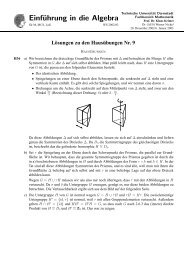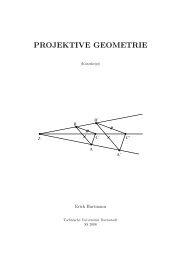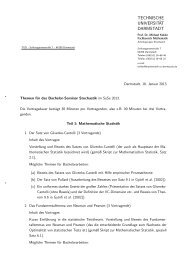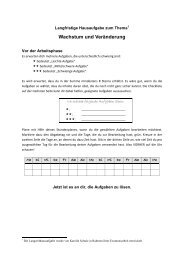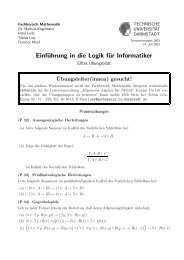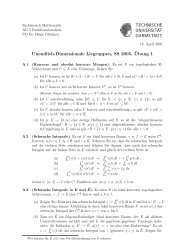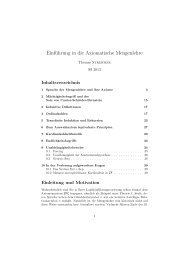bogovski˘i's operator in sobolev spaces - Fachbereich Mathematik ...
bogovski˘i's operator in sobolev spaces - Fachbereich Mathematik ...
bogovski˘i's operator in sobolev spaces - Fachbereich Mathematik ...
Create successful ePaper yourself
Turn your PDF publications into a flip-book with our unique Google optimized e-Paper software.
ON THE EQUATION div u = g AND BOGOVSKIĬ’S OPERATOR IN<br />
SOBOLEV SPACES OF NEGATIVE ORDER<br />
MATTHIAS GEISSERT, HORST HECK, AND MATTHIAS HIEBER<br />
Dedicated to Philippe Clément on the Occasion of his 60-th Birthday<br />
Abstract. Consider the divergence problem with homogeneous Dirichlet data on a Lipschitz<br />
doma<strong>in</strong>. Two approaches for its solutions <strong>in</strong> the scale of Sobolev <strong>spaces</strong> are presented. The<br />
first one is based on Calderón-Zygmund theory, whereas the second one relies on the Stokes<br />
equation with <strong>in</strong>homogeneous data.<br />
1. Introduction<br />
The solution of many problems <strong>in</strong> hydrodynamics requires a thorough understand<strong>in</strong>g of the structure<br />
of the solutions of the equation div u = g for a given scalar valued function g. Hence, given a<br />
doma<strong>in</strong> Ω ⊂ R n , quite a few authors (see e.g. [Cat61], [Lad69], [Neč67], [S ˇ S73], [Bog79], [Bog80],<br />
[Pil83], [Sol83], [vW90], [BS90], [FS94], [Gal94], [Soh01]) dealt with the problem<br />
(1.1)<br />
� div u = g <strong>in</strong> Ω<br />
u |∂Ω = 0 on ∂Ω.<br />
There are several approaches to prove the existence of a solution to problem (1.1), see [Bog79],<br />
[Gal94], [vW90] and [Pil83]. Observe also that the solution to this problem is not unique.<br />
Bogovskiĭ proved the existence and a-priori estimates for a solution to (1.1) <strong>in</strong> the scale of<br />
Sobolev <strong>spaces</strong> of positive order provided Ω ⊂ R n is a Lipschitz doma<strong>in</strong>, n ≥ 2 and g ∈ L p (Ω)<br />
satisfies �<br />
Ω g = 0. Here 1 < p < ∞. His approach is based on an explicit representation formula<br />
for u on star shaped doma<strong>in</strong>s. This representation of u as a s<strong>in</strong>gular <strong>in</strong>tegral allows to apply<br />
Calderón-Zygmund theory and estimates for u <strong>in</strong> Sobolev <strong>spaces</strong> of positive order follow thus by<br />
this theory.<br />
In this paper we prove that Bogovskiĭ’s solution <strong>operator</strong> B can be extended cont<strong>in</strong>uously to<br />
an <strong>operator</strong> act<strong>in</strong>g from W s,p<br />
0 (Ω) to W s+1,p<br />
0 (Ω) n provided s > −2 + 1/p. Our approach is based<br />
on properties of the adjo<strong>in</strong>t kernel of K, K associated to B, see also [BS90], [MM05]. Results of<br />
this type are quite useful <strong>in</strong> the study of the Navier-Stokes flow past rotat<strong>in</strong>g obstacles, see e.g<br />
[GHH04]. Note that the case s = −1 was already considered by Borchers and Sohr <strong>in</strong> [BS90]; see<br />
however [FS94] and the footnote on page 180 of Galdi’s book [Gal94].<br />
Key words and phrases. Divergence Problem, Bogovskiĭ’s <strong>operator</strong>.<br />
The second author was f<strong>in</strong>ancially supported by the JSPS.<br />
1
2 MATTHIAS GEISSERT, HORST HECK, AND MATTHIAS HIEBER<br />
A completely different approach to equation (1.1) is based on estimates for the solution of the<br />
<strong>in</strong>homogeneous Stokes system<br />
(1.2)<br />
−∆u + ∇p = f <strong>in</strong> Ω<br />
div u = g <strong>in</strong> Ω<br />
u = 0 on ∂Ω,<br />
see Section 3. Sett<strong>in</strong>g f = 0 and Bg := u, where (u, p) is the solution to problem (1.2), one obta<strong>in</strong>s<br />
by this approach <strong>in</strong> particular estimates for the solution to problem (1.1) provided g ∈ � W 1,p (Ω)<br />
or g ∈ � W −1,p (Ω). In Section 3 we extend this approach to g ∈ � W s,p (Ω) for all s ∈ [−1, 1]. For<br />
related problems as e.g. groundwater flow we refer to [CL93].<br />
2. Approach by an explicit representation formula<br />
Let Ω ⊂ R n be a doma<strong>in</strong> and let 1 < p < ∞. For s ≥ 0 we denote by (W s,p (Ω), � · � W s,p (Ω)) the<br />
usual Sobolev <strong>spaces</strong>, see e.g. [Tri95]. Furthermore, let W s,p<br />
0 (Ω) := C ∞ c (Ω) �·� W s,p (Ω)<br />
. For s < 0<br />
we set<br />
where 1<br />
p<br />
W s,p (Ω) := (W −s,p′<br />
0 (Ω)) ′ and W s,p<br />
0 (Ω) := (W −s,p′<br />
(Ω)) ′ ,<br />
+ 1<br />
p ′ = 1. Note that C ∞ c<br />
(Ω) is dense <strong>in</strong> W s,p<br />
0 (Ω) for all s ∈ R.<br />
Our first proposition relies on the fact that for bounded and star shaped doma<strong>in</strong>s with respect<br />
to a ball K a solution to� problem (1.1) can be written as a s<strong>in</strong>gular <strong>in</strong>tegral. More precisely,<br />
(K) with<br />
choose ω ∈ C ∞ c<br />
(2.1)<br />
(Big)(x) :=<br />
K ω = 1 and def<strong>in</strong>e for g ∈ C∞ c (Ω)<br />
�<br />
Ω<br />
g(y) xi − yi<br />
|x − y| n<br />
where x = (x1, . . . , xn) and i = 1, . . . , n.<br />
Then the follow<strong>in</strong>g holds.<br />
�<br />
0<br />
∞<br />
x − y<br />
ω(x + r<br />
|x − y| )(|x − y| + r)n−1 dr dy,<br />
Proposition 2.1. Let 1 < p < ∞ and Ω ⊂ R n be a bounded and star shaped doma<strong>in</strong> with respect<br />
to some ball. Let g ∈ L p (Ω). Then B := (B1, . . . , Bn) satisfies<br />
and<br />
BC ∞ c (Ω) ⊂ C ∞ c (Ω) n<br />
�<br />
∇ · Bg = g − ω<br />
Ω<br />
g for g ∈ L p (Ω).<br />
Moreover, for s > −2 + 1<br />
s,p<br />
p , B can be cont<strong>in</strong>uously extended to a bounded <strong>operator</strong> from W0 (Ω)<br />
to W s+1,p<br />
0 (Ω) n .<br />
Proof. The case s ≥ 0 was already treated by Bogovskiĭ <strong>in</strong> [Bog79]. There it is proved that<br />
BiC ∞ c (Ω) ⊂ C∞ c (Ω)n . Moreover, by Calderón-Zygmund theory for the s<strong>in</strong>gular <strong>in</strong>tegral (2.1) one<br />
obta<strong>in</strong>s the assertion for s ≥ 0. For a detailed proof see [Gal94, Lemma III.3.1].
ON THE EQUATION div u = g 3<br />
In the follow<strong>in</strong>g we prove the assertion for s < 0 by duality. In fact, the kernel of the adjo<strong>in</strong>t<br />
B ∗ i of the <strong>operator</strong> Bi is given by<br />
K ∗ i (x, x − y) = − xi − yi<br />
|x − y| n<br />
S<strong>in</strong>ce<br />
�<br />
∞<br />
0<br />
∞<br />
1<br />
x − y<br />
ω(y − r<br />
|x − y| n )(|x − y| + r)n−1 dr<br />
�<br />
= −(xi − yi) ω(x − r(x − y))r n−1 dr<br />
�∞<br />
= −(xi − yi) ω(x − r(x − y))r n−1 �1<br />
dr + (xi − yi) ω(x − r(x − y))r n−1 dr<br />
= − xi − yi<br />
|x − y| n<br />
0<br />
�∞<br />
x − y<br />
ω(x − r<br />
|x − y| )rn−1 �1<br />
dr + (xi − yi) ω(x − r(x − y))r n−1 dr<br />
=: K ∗ i,s<strong>in</strong>g (x, x − y) + K∗ i,bdd<br />
0<br />
(x, x − y).<br />
|∂xj K ∗ i,bdd (x, x − y)| ≤ C, i, j = 1, . . . , n, x ∈ Ω, y ∈ Rn ,<br />
it follows that the <strong>operator</strong> associated to the kernel K ∗ i,bdd cont<strong>in</strong>uously maps Lp (Ω) <strong>in</strong>to W 1,p (Ω).<br />
We thus consider <strong>in</strong> the follow<strong>in</strong>g the contribution of K ∗ i,s<strong>in</strong>g . Similarly as <strong>in</strong> the proof of [Gal94,<br />
Lemma III.3.1], the kernel ∂xj K∗ i,s<strong>in</strong>g can be decomposed <strong>in</strong> a weakly s<strong>in</strong>gular kernel K ∗ i,s<strong>in</strong>g,w and<br />
a Calderón-Zygmund kernel K∗ i,s<strong>in</strong>g,CZ . More precisely, ∂xj K∗ i,s<strong>in</strong>g can be rewritten as<br />
with<br />
∂xj K ∗ i,s<strong>in</strong>g = K∗ i,s<strong>in</strong>g,w + K∗ i,s<strong>in</strong>g,CZ ,<br />
K ∗ i,s<strong>in</strong>g,w(x, x − y) = − xi − yi<br />
|x − y| n<br />
K ∗ i,s<strong>in</strong>g,CZ(x, x − y) =<br />
−δij<br />
|x − y| n<br />
�∞<br />
0<br />
∞<br />
satisfies the follow<strong>in</strong>g properties<br />
�<br />
0<br />
x − y<br />
(∂xj ω)(x − r<br />
|x − y| )rn−1 dr,<br />
x − y<br />
ω(x − r<br />
|x − y| )rn−1 dr<br />
+ xi − yi<br />
|x − y| n+1<br />
�∞<br />
x − y<br />
(∂xj ω)(x − r<br />
|x − y| )rn dr.<br />
Note that K∗ i,s<strong>in</strong>g,CZ<br />
(a) K∗ i,s<strong>in</strong>g,CZ (x, z) = α−nK ∗ i,s<strong>in</strong>g,CZ (x, αz), x ∈ Ω, z ∈ Rn , α > 0,<br />
(b) �<br />
|z|=1 K∗ i,s<strong>in</strong>g,CZ (x, z) dz = 0, x ∈ Ω,<br />
(c) |K∗ i,s<strong>in</strong>g,CZ (x, z)| ≤ C, x ∈ Ω, |z| = 1.<br />
It follows from classical Calderón-Zygmund theory [CZ56], [Ste93] that<br />
B ∗ i ∈ L(L p (Ω), W 1,p (Ω)).<br />
0<br />
0<br />
0
4 MATTHIAS GEISSERT, HORST HECK, AND MATTHIAS HIEBER<br />
Moreover,<br />
B ∗ i<br />
∈ L(W ˜s,p<br />
0 (Ω), W ˜s+1,p (Ω)), ˜s > 0<br />
by [Gal94, Remark III.3.1] and real <strong>in</strong>terpolation. S<strong>in</strong>ce W s,p<br />
0 (Ω) = W s,p (Ω) for −1 + 1<br />
p<br />
we obta<strong>in</strong><br />
B ∈ L(W s,p<br />
0 (Ω), W s+1,p<br />
0 (Ω) n ), −2 + 1<br />
< s < −1.<br />
p<br />
< s < 1<br />
p ,<br />
The rema<strong>in</strong><strong>in</strong>g cases f<strong>in</strong>ally follow by real <strong>in</strong>terpolation. �<br />
Remark 2.2. (a) It should be emphasized that <strong>in</strong> the above proposition, the <strong>operator</strong> B is<br />
def<strong>in</strong>ed for all g ∈ Lp (Ω) whereas Bogovskiĭ [Bog79], von Wahl [vW90] and Galdi [Gal94]<br />
constructed solutions to the problem (1.1). The latter is only possible if �<br />
Ω g = 0. Hence,<br />
�B<br />
may be regarded as extension of the solution <strong>operator</strong> to problem (1.1). However, if<br />
g �= 0, then Bg is not a solution to (1.1).<br />
Ω<br />
(b) The idea of us<strong>in</strong>g the adjo<strong>in</strong>t kernel to prove estimates for B <strong>in</strong> Sobolev <strong>spaces</strong> of negative<br />
order is quite natural and was already used <strong>in</strong> [BS90] for the case s = −1. More recently,<br />
this approach was also reconsidered by [MM05].<br />
(c) There is a considerable difference between Bi and its adjo<strong>in</strong>t B∗ i . As BiC ∞ c (Ω) ⊂ C∞ c (Ω),<br />
this does not hold true for its adjo<strong>in</strong>t.<br />
(d) The above proof shows that B ∈ L(W s,p<br />
0 (Ω), W s+1,p (Ω) n ) for s ≤ −1.<br />
Bounded and locally Lipschitz doma<strong>in</strong>s have the remarkable property that they can be written<br />
as a f<strong>in</strong>ite union of star shaped doma<strong>in</strong>s. This gives us the possibility to carry over mapp<strong>in</strong>g<br />
properties of the <strong>operator</strong> B, orig<strong>in</strong>ally def<strong>in</strong>ed on star shaped doma<strong>in</strong>s, to locally Lipschitz<br />
doma<strong>in</strong>s. For convenience and to fix notation we first state a result concern<strong>in</strong>g the decomposition<br />
of Lipschitz doma<strong>in</strong>s <strong>in</strong>to star shaped doma<strong>in</strong>s. For a proof of this result we refer to [Gal94,<br />
Lemma III.3.4].<br />
Lemma 2.3. Let Ω ⊂ Rn be a bounded and locally Lipschitz doma<strong>in</strong>. Then there exist m ∈ N<br />
and an open cover G = {Gi : i ∈ {1, . . . , m}} of Ω such that for 1 ≤ i ≤ m the set Ωi = Ω ∩ Gi is<br />
star shaped with respect to some ball and Ω = �m i=1 Ωi.<br />
Moreover, there exist φi ∈ C∞ c (Gi), mi ∈ N, θi,k ∈ C∞ c (Ωi) and ψi,k ∈ C∞ c (Ω) (i ∈<br />
{1, . . . , m}, k ∈ {1, . . . , mi}) such that<br />
mi �<br />
�<br />
Pig := φig + ψi,kg, g ∈ C ∞ c (Ω)<br />
k=1<br />
θi,k<br />
satisfies Pig ∈ C∞ c (Ωi) and �<br />
Ω Pig = 0. In addition, if �<br />
g = �m i=1 Pig.<br />
Ω<br />
Ω<br />
g = 0 we get a decomposition of g by<br />
In order to def<strong>in</strong>e a solution <strong>operator</strong> to (1.1) for bounded, locally Lipschitz doma<strong>in</strong>s we<br />
reconsider the <strong>operator</strong>s Pi.<br />
Lemma 2.4. Let 1 < p < ∞, s ∈ R and let Ωi and Pi be def<strong>in</strong>ed as <strong>in</strong> Lemma 2.3 for i = 1, . . . , m.<br />
Then<br />
Pi ∈ L(W s,p<br />
0 (Ω), W s,p<br />
0 (Ωi)), s ∈ R, 1 < p < ∞.
ON THE EQUATION div u = g 5<br />
Proof. Let i ∈ {1, . . . , m}. Consider first the case where s ≥ 0. Then there exists C > 0 such<br />
that<br />
�Pig� W s,p<br />
0 (Ωi) ≤ C�g� W s,p<br />
0 (Ω), g ∈ W s,p<br />
0 (Ω).<br />
In order to prove the rema<strong>in</strong><strong>in</strong>g cases, let s > 0, g ∈ C ∞ c (Ω) and v ∈ W s,p′ (Ωi), 1 1<br />
p + p ′ = 1. Then<br />
�<br />
|〈Pig, v〉| = |<br />
Ωi<br />
Ωi<br />
φ(x)g(x)v(x) +<br />
m�<br />
k=1<br />
�<br />
θi,k(x)v(x)<br />
k=1<br />
Ω<br />
Ω<br />
ψi,k(y)g(y) dy dx|<br />
�<br />
m�<br />
�<br />
�<br />
= | g(x)φ(x)v(x) dx + ψi,k(y)g(y) θi,k(x)v(x) dx dy|<br />
≤ �g� −s,p<br />
W0 (Ω) �φv�W s,p′ (Ω) + �g�W −s,p<br />
0 (Ω)<br />
�ψi,k<br />
k=1<br />
Ω<br />
θi,k(x)v(x) dx�W s,p ′ (Ωi)<br />
≤ C�g� −s,p<br />
W0 (Ω) �v�W s,p′ (Ωi)<br />
where C is some constant <strong>in</strong>dependent of g and v. �<br />
The follow<strong>in</strong>g theorem is the ma<strong>in</strong> result of this paper. Besides its <strong>in</strong>terest <strong>in</strong> its own, there<br />
are many applications of the use of Bogovskiĭ’s <strong>operator</strong> <strong>in</strong> Sobolev <strong>spaces</strong> of negative order; see<br />
e.g. the recent paper [GHH04].<br />
Theorem 2.5. Let Ω ⊂ Rn be a bounded doma<strong>in</strong> with a locally Lipschitz boundary. Then there<br />
exists B : C∞ c (Ω) → C∞ c (Ω) n such that<br />
∇ · Bg = g, g ∈ L p �<br />
(Ω) with g = 0.<br />
Moreover, B can be extended cont<strong>in</strong>uously to a bounded <strong>operator</strong> from W s,p<br />
0 (Ω) to W s+1,p<br />
0 (Ω) n<br />
provided s > −2 + 1<br />
p .<br />
Proof. Let g ∈ C ∞ c (Ω). Consider the decomposition of Ω and the associated <strong>operator</strong>s Pi def<strong>in</strong>ed<br />
as <strong>in</strong> Lemma 2.3. Then<br />
(2.2)<br />
i=1<br />
Ω<br />
Ω<br />
m�<br />
m�<br />
�<br />
Pig = g provided g(x) dx = 0.<br />
Denote the <strong>operator</strong> def<strong>in</strong>ed <strong>in</strong> Proposition 2.1 act<strong>in</strong>g on Ωi by Bi and set Bg := �m i=1 BiPig.<br />
Then by Proposition 2.1 and Lemma 2.4, B ∈ L(W s,p<br />
0 (Ω), W s+1,p<br />
0 (Ω) n ) for all s ≥ 0 s<strong>in</strong>ce<br />
BiPiC ∞ c (Ω) ⊂ C∞ c (Ωi) n .<br />
Aga<strong>in</strong>, by Proposition 2.1 and Lemma 2.4<br />
|〈Bg, v〉| =<br />
�<br />
|<br />
m�<br />
m�<br />
�<br />
BiPig(x)v(x) dx| = | BiPig(x)v(x) dx|<br />
≤ C<br />
Ω<br />
i=1<br />
m�<br />
i=1<br />
Ω<br />
i=1<br />
Ωi<br />
�Pig� −s,p<br />
W0 (Ωi) �v�W s,p′ (Ωi)<br />
≤ C�g� −s,p<br />
W0 (Ω) �v�W s,p′ (Ω) , g ∈ C∞ c (Ω), v ∈ W s,p′<br />
(Ω).<br />
�
6 MATTHIAS GEISSERT, HORST HECK, AND MATTHIAS HIEBER<br />
F<strong>in</strong>ally, by (2.2) we obta<strong>in</strong><br />
m�<br />
m�<br />
∇ · Bg = ∇ · BiPig = Pig = g, g ∈ L p (Ω),<br />
�<br />
g(x) dx = 0.<br />
i=1<br />
i=1<br />
3. Approach by the <strong>in</strong>homogeneous Stokes equation<br />
We start this section by consider<strong>in</strong>g the problem<br />
(3.1)<br />
−∆u + ∇p = f <strong>in</strong> Ω<br />
div u = g <strong>in</strong> Ω<br />
u = 0 on ∂Ω<br />
where Ω ⊂ R n for n ≥ 2 is a bounded doma<strong>in</strong> with boundary ∂Ω ∈ C 2 . Let 1 < p, p ′ < ∞ such<br />
that 1 = 1<br />
p<br />
+ 1<br />
p ′ .<br />
We then set L p<br />
0 (Ω) := {f ∈ Lp (Ω) : �<br />
Ω f = 0} and for s ∈ [0, 1] let � W s,p (Ω) := W s,p (Ω)∩L p<br />
0 (Ω)<br />
equipped with the norm <strong>in</strong> W s,p (Ω). Furthermore, we def<strong>in</strong>e � W −s,p (Ω) := ( � W s,p′ (Ω)) ′ equipped<br />
with the usual dual norm.<br />
Note that for g ∈ � W 1,p (Ω) we have<br />
�g� cW −1,p (Ω) = sup<br />
v∈ c W 1,p (Ω)\{0}<br />
|〈g, v〉|<br />
�v� W 1,p ′ (Ω)<br />
The follow<strong>in</strong>g proposition is due to Farwig and Sohr [FS94].<br />
Ω<br />
≤ �g� −1,p<br />
W0 (Ω) .<br />
Proposition 3.1. Let Ω ⊂ Rn be a bounded doma<strong>in</strong> with C2-boundary. Let 1 < p < ∞. Then<br />
there exists a bounded <strong>operator</strong> R : � W 1,p (Ω) → W 2,p (Ω) n ∩ W 1,p<br />
0 (Ω) n such that div Rg = g.<br />
Moreover, R satisfies the follow<strong>in</strong>g estimates:<br />
(a) �Rg�Lp (Ω) ≤ C�g�cW −1,p ≤ C�g� −1,p<br />
(Ω) W0 (Ω) ,<br />
(b) �Rg�W 2,p (Ω) ≤ C�g�W 1,p (Ω).<br />
Here C > 0 is a constant depend<strong>in</strong>g on Ω and p only.<br />
Sett<strong>in</strong>g f = 0 and Rg := u, where (u, p) is the solution of (3.1) the assertion above is a direct<br />
consequence of the unique solvability of the problem (3.1) with f ∈ (Lp (Ω)) n and g ∈ � W 1,p (Ω).<br />
Similarly, we obta<strong>in</strong> the fact that R ∈ L(L p<br />
0 (Ω), (W 1,p (Ω)) n ) from the unique solvability of<br />
the problem (3.1) for f ∈ W −1,p (Ω) n and g ∈ L p<br />
0<br />
(Ω). In fact, s<strong>in</strong>ce (u, p) is the unique solution<br />
of (3.1), the <strong>operator</strong> R given <strong>in</strong> Proposition 3.1 may be thus extended from � W 1,p (Ω) to L p<br />
0 (Ω).<br />
Unique solvability of (3.1) <strong>in</strong> the given sett<strong>in</strong>g was first proved by Cattabriga [Cat61] for the case<br />
n = 3 and by Galdi and Simader [GS90] for general n ≥ 2. See also [KS91] for a different proof.<br />
We summarize these facts <strong>in</strong> the next proposition.<br />
Proposition 3.2. Let 1 < p < ∞ and let Ω ⊂ Rn be a bounded doma<strong>in</strong> with C2-boundary. Then<br />
for every f ∈ W −1,p (Ω) n and g ∈ L p<br />
1,p<br />
0 (Ω) there exists a unique solution (u, p) ∈ W0 (Ω) n × L p<br />
0 (Ω)<br />
of (3.1) satisfy<strong>in</strong>g the <strong>in</strong>equality<br />
for some constant C = C(Ω, n, p).<br />
�∇u� L p (Ω) + �p� L p (Ω) ≤ C(�f� W −1,p (Ω) n + �g� L p (Ω))<br />
�
ON THE EQUATION div u = g 7<br />
Not<strong>in</strong>g that (L p′<br />
0 (Ω), the follow<strong>in</strong>g lemma implies that Lp<br />
The proof is standard and therefore omitted.<br />
0 (Ω))′ = L p<br />
0 (Ω) is dense <strong>in</strong> � W −1,p (Ω).<br />
Lemma 3.3. Let X, Y be Banach <strong>spaces</strong>. Assume that X is densely embedded <strong>in</strong> Y and that X<br />
is reflexive. Then the closure of Y ′ is X ′ .<br />
Comb<strong>in</strong><strong>in</strong>g the above results, we may def<strong>in</strong>e a solution <strong>operator</strong> for the divergence problem<br />
(1.1) <strong>in</strong> the follow<strong>in</strong>g <strong>spaces</strong><br />
⎧<br />
⎪⎨<br />
R :<br />
⎪⎩<br />
�W −1,p (Ω) → Lp (Ω) n<br />
�W 1,p (Ω) → W 2,p (Ω) n ∩ W 1,p<br />
0 (Ω) n<br />
L p<br />
0 (Ω) →<br />
1,p<br />
W0 (Ω) n<br />
The follow<strong>in</strong>g result gives additional mapp<strong>in</strong>g properties of R <strong>in</strong> the scale of Sobolev <strong>spaces</strong>.<br />
Theorem 3.4. Let 1 < p < ∞ and let Ω ⊂ Rn be a bounded doma<strong>in</strong> with C2-boundary. Let<br />
s ∈ [−1, 1]. Then there exists a bounded l<strong>in</strong>ear <strong>operator</strong> R : � W s,p (Ω) → W s+1<br />
0 (Ω) n such that<br />
div Rg = g for all g ∈ � W s,p (Ω).<br />
Proof. The cases s = 1 and s = −1 follow from Proposition 3.1. Consider next the case where<br />
0 ≤ s < 1. Denote by K the set of all constant functions over Ω. Then we may identify the <strong>spaces</strong><br />
L p<br />
0 (Ω) with Lp (Ω)/K and � W 1,p (Ω) with W 1,p (Ω)/K, respectively. As K is a one-dimensional<br />
vector space, it follows from [Tri95, Section 1.17.2, Remark 1] that<br />
(L p<br />
0 (Ω), � W 1,p (Ω))s,p = (L p (Ω)/K, W 1,p (Ω)/K)s,p = (L p (Ω), W 1,p (Ω))s,p/K = � W s,p (Ω).<br />
This implies the assertion provided 0 ≤ s < 1.<br />
In order to prove the rema<strong>in</strong><strong>in</strong>g case where −1 < s < 0, note that (L p′<br />
0 (Ω), � W 1,p′ (Ω)) ′ s,p ′ =<br />
(L p<br />
0 (Ω), � W −1,p (Ω))s,p; see e.g. [Tri95, Section 1.11.2]. Hence,<br />
�W −s,p (Ω) = (L p′<br />
0 (Ω), � W 1,p′<br />
(Ω)) ′ s,p ′ = (Lp 0 (Ω), � W −1,p (Ω))s,p<br />
and the proof is complete. �<br />
Remark 3.5. The assertions of Theorems 2.5 and 3.4 rema<strong>in</strong> valid also for the complex <strong>in</strong>terpolation<br />
<strong>spaces</strong>. In fact, the above mapp<strong>in</strong>g properties of B and R <strong>in</strong> the scale of Sobolev <strong>spaces</strong><br />
hold true also <strong>in</strong> the scale of the <strong>spaces</strong> H s,p (Ω) and � H s,p (Ω), respectively.<br />
Acknowledgements<br />
The authors would like to thank S. Monniaux and H. Sohr for fruitful discussions and for<br />
po<strong>in</strong>t<strong>in</strong>g out the reference [MM05]. The second author is also grateful to H. Kozono for valuable<br />
comments and the warm hospitality dur<strong>in</strong>g his stay at Tohoku University, Sendai, Japan.
8 MATTHIAS GEISSERT, HORST HECK, AND MATTHIAS HIEBER<br />
References<br />
[Bog79] M. E. Bogovskiĭ, Solution of the first boundary value problem for an equation of cont<strong>in</strong>uity of an<br />
<strong>in</strong>compressible medium. Dokl. Akad. Nauk SSSR. 248 (1979), (5), 1037–1040.<br />
[Bog80] M. E. Bogovskiĭ, Solution of some vector analysis problems connected with <strong>operator</strong>s div and grad. Trudy<br />
Sem<strong>in</strong>ar S. Sobolev, No. 1, 1980, Akademia Nauk SSSR, Sibirskoe Otdelnie Matematiki, Novosibirsk,<br />
(1980), 5–40.<br />
[BS90] W. Borchers and H. Sohr, On the equations rot v = g and div u = f with zero boundary conditions,<br />
Hokkaido Math. J. 19 (1990), (1), 67–87.<br />
[Cat61] L. Cattabriga, Su un problema al contorno relativo al sistema di equazioni di Stokes, Rend. Sem. Mat.<br />
Univ. Padova 31 (1961), 308–340.<br />
[CL93] P. Clément, and S. Li, Abstract parabolic quasil<strong>in</strong>ear equations and application to a groundwater flow<br />
problem, Adv. Math. Sci. Appl., 3 (1993/94), 17–32.<br />
[CZ56] A. P. Calderón and A. Zygmund, On s<strong>in</strong>gular <strong>in</strong>tegrals, Amer. J. Math. 78 (1956), 289–309.<br />
[FS94] R. Farwig and H. Sohr, Generalized resolvent estimates for the Stokes system <strong>in</strong> bounded and unbounded<br />
doma<strong>in</strong>s, J. Math. Soc. Japan 46 (1994), (4), 607–643.<br />
[Gal94] G. P. Galdi, An <strong>in</strong>troduction to the mathematical theory of the Navier-Stokes equations. Vol. I, Spr<strong>in</strong>ger,<br />
1994, L<strong>in</strong>earized steady problems.<br />
[GHH04] M. Geißert, H. Heck, and M. Hieber, L p -theory of the Navier-Stokes flow <strong>in</strong> the exterior of a mov<strong>in</strong>g<br />
or rotat<strong>in</strong>g obstacle. Prepr<strong>in</strong>t, TU Darmstadt, 2004.<br />
[GS90] G. P. Galdi and C. G. Simader, Existence, uniqueness and L q -estimates for the Stokes problem <strong>in</strong> an<br />
exterior doma<strong>in</strong>. Arch. Ration. Mech. Anal. 112 (1990), (4), 291–318.<br />
[KS91] H. Kozono and H. Sohr, New a priori estimates for the Stokes equations <strong>in</strong> exterior doma<strong>in</strong>s. Indiana<br />
Univ. Math. J. 40 (1991), (1), 1–27.<br />
[Lad69] O. A. Ladyzhenskaya, The Mathematical Theory of Viscous Incompressible Flow. Gordon and Breach,<br />
1969.<br />
[MM05] D. Mitrea and M. Mitrea, The Poisson problem for the exterior derivative <strong>operator</strong> with Dirichlet<br />
boundary condition <strong>in</strong> Sobolev-Besov <strong>spaces</strong> on nonsmooth doma<strong>in</strong>s. Prepr<strong>in</strong>t, 2005.<br />
[Neč67] J. Nečas, Les méthodes directes en théorie des équations elliptiques, Masson et Cie, Paris, 1967.<br />
[Pil83] K. Pileckas, Three-dimensional solenoidal vectors. J. Soviet Math. 21 (1983), 821–823.<br />
[Soh01] H. Sohr, The Navier-Stokes Equations. An Elementary Functional Analytic Approach. Birkhäuser, 2001.<br />
[Sol83] V. A. Solonnikov, Stokes and Navier-Stokes equations <strong>in</strong> doma<strong>in</strong>s with noncompact boundaries, In:<br />
Nonl<strong>in</strong>ear partial differential equations and their applications. Collège de France Sem<strong>in</strong>ar, Vol. IV (Paris,<br />
1981/1982), Res. Notes <strong>in</strong> Math., vol. 84, Pitman, 1983, 240–349.<br />
[S ˇ S73] V. A. Solonnikov and V. E. ˇ Sčadilov, On a boundary value problem for stationary Navier-Stokes equations,<br />
Proc. Steklov Math. Inst. 125 (1973), 186–199.<br />
[Ste93] E. M. Ste<strong>in</strong>, Harmonic Analysis: Real-Variable Methods, Orthogonality, and Oscillatory Integrals,<br />
Pr<strong>in</strong>ceton University Press, Pr<strong>in</strong>ceton, NJ, 1993.<br />
[Tri95] H. Triebel, Interpolation Theory, Function Spaces, Differential Operators, 2nd ed. Johann Ambrosius<br />
Barth, Heidelberg, Leipzig, 1995.<br />
[vW90] W. von Wahl, On necessary and sufficient conditions for the solvability of the equations rot u = γ and<br />
div u = ɛ with u vanish<strong>in</strong>g on the boundary, The Navier-Stokes equations (Oberwolfach, 1988), Spr<strong>in</strong>ger<br />
Lecture Notes <strong>in</strong> Math 1431, 1990, 152–157.<br />
Technische Universität Darmstadt, <strong>Fachbereich</strong> <strong>Mathematik</strong>, Schlossgartenstr. 7, D-64289 Darmstadt,<br />
Germany<br />
E-mail address, M. Geissert: geissert@mathematik.tu-darmstadt.de<br />
E-mail address, H. Heck: heck@mathematik.tu-darmstadt.de<br />
E-mail address, M. Hieber: hieber@mathematik.tu-darmstadt.de



